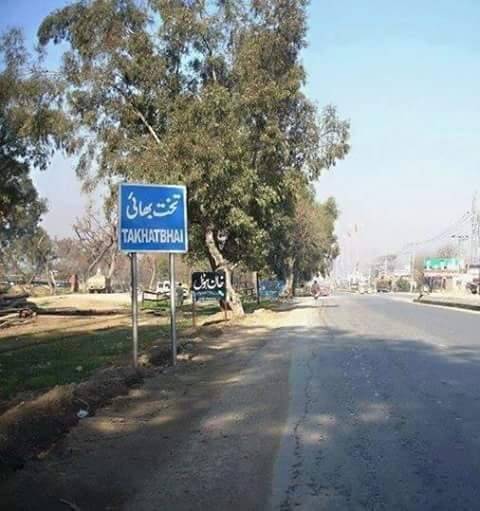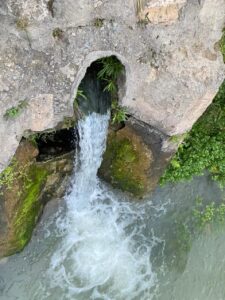
A small town in Pakistan's north western province of Khyber Pakhtunkhwa, noted for its verdant green fields and named "Takht-i-Bahi" after the top or throne spring, is on the verge of losing its identity as the locals of the Buddha town are leaving their homes due to the region's water deficiency. In the Mazdoor Abad area of the tehsil, the declining level of underground water has forced many to leave behind their ancestral properties and seek shelter in areas where water is abundantly available.
Janwari Babo, a 60 year old woman who used to sell different things door to door in the Mazdoor Abad for the last 25 years has witnessed the development of a water scarcity crisis in the area. She spoke about how sometimes she sells merchandise in the area without having a drop of water because people of the area doesn’t meet the sufficient amount of water even for their drinking. “The locals are willing to let you borrow their gold, but they are unwilling to give you a sip of water to drink” she added.
Mian Mohibullah, a local said that for the past five years, they are facing water issues and tried to address them in many ways. However, he said that the issue was aggravating. He argued, drought is the only reason for water shortage and affirmed that whenever it rains, the water level raises. Nonetheless, he stated that when there is no rain, the people have to be forced to fetch water from neighbouring villages.
 The Tehsil Municipal Administration (TMA) Takht-i-Bahi reports that between 80-100 families from Chinna (Spring) village have left their houses because of this issue. Locals also attributed the severity of the problem to the area's sewage system.
The Tehsil Municipal Administration (TMA) Takht-i-Bahi reports that between 80-100 families from Chinna (Spring) village have left their houses because of this issue. Locals also attributed the severity of the problem to the area's sewage system.
Water harvesting and recharge have had a significant impact on water shortage, according to Muhammad Qasim, professor of environmental science at the University of Swat. This is because as the population has grown, water harvesting has increased, which has led to a drop in water recharge. Furthermore, other causes have also played a vital role in it, like irregular rainfall, and change in land usage which include crust change. Nevertheless, the key role has played in all this problem is bogs' conversion to agricultural land. This is a process in which pipelines are used to evacuate extra water from a specific area and bring it into useful agricultural land. Therefore, it caused water scarcity in the region that will ultimately leave repercussions in the region.
Pakistan is already among the water-stressed nations; however, the recent floods have further exacerbated the water shortage problem. People globally face a water scarcity crisis. How this extremity surfaced is solely related to human activities. Naturally, some regions are water deficient while others are commanding abundant freshwater resources. Yet, the demand for freshwater has extended as the global population is enhancing. Water scarcity in simple terms is defined as inadequate or depleted freshwater resources that can no longer serve the standard water demand of a particular area. Water scarcity in Pakistan is the biggest problem that mustn't be ignored.
In the country, a large portion of the population does not have access to freshwater resources. People living in Sindh and Baluchistan are facing sensitive water scarcity problems. It's frequently heard in the news that the authority will install desalination plants to meet water demand specifically in desert areas, but the practical performance of the released statements is unseen. Lack of access to clean, safe water affects not only drinking but also everyday hygiene routines in homes, workplaces, schools, etc. According to Muhammad Qasim, the harmful consequences of water scarcity affect all living things in a community, including plants, animals, and humans.

As per Dr Jan Muhammad District Director of Agriculture, Lower Swat said that salinity control and reclamation project (SCARP) were completed in the year 1992 to make better the poor drainage. “Farming on the Swat canal irrigation system was suffering from salt and rising water table.”
He mentioned that the project was installed to overcome the problem with tile drainage and to improve services to farmers through better water delivery. He figured out that the project aimed to benefit the farming area of 85,000 acres (ha) in district Mardan only.
He spoke about the water scarcity crisis in the Chinna (spring ) village related to the SCARP system installed in the areas near the affected village. “It had caused to down the water table as the village is located on the slope area of the district and this project had had some effect on the problem creation.” He stressed that including to the shortage of drinking water in the buddha town, the SCARP also had put bad impacts on the agricultural land.
Local farmer Noor Zameen said that although we previously used three times as much non-organic fertiliser, we now use five to six times as much of it to maintain the target breed.
The flood irrigation system is not assessing to carry water to the soil veins, according to Dr Jan, who identified the issue, and said that SCARP was to blame for it. He noted that the SCARP is not the only assailant but the excessive use of plastic bags and overpopulation both contribute significantly to this grave issue.
According to the ENVPK report: “Nowadays, Pakistan is known as the water-troubled country that would momentarily take the title of the water-scarce country shortly unless strong water conservation strategies and administration plans are enforced. In 2018, it was said in an international report that, by 2025 Pakistan would turn into a water-scarce country due to depleted water resources. A campaign was started by the Government of Pakistan to collect funds for Dams to overcome the problem. The purpose of this movement was the construction of New Dams because of the decreased water storage position in Mangla and Tarbela Dams.
Water Resources:
In Pakistan, water is obtained from rainfall, rivers, groundwater, and glaciers. The country's rainfall pattern is constantly shifting from region to region, with some areas receiving more rain and others receiving less. The surface and groundwater sources of the country are related to the Indus River Basin. Pakistan has drastically changed from an existing water-abundant country to a water-troubled country Over the last decades and with 2.8 per cent of the global population, Pakistan accounts for 0.5 per cent of universal renewable water resources. The Pakistan Council of Scientific and Industrial Research has advised about fleetly depleting water resources in Khyber Pakhtunkhwa as well as in the near Federally Administered Tribal Areas. The water surface is being filled in with metals due to which the availability of the commodity growing scarce. People have been using hard water in most parts of the KP and FATA because it passes through underground rocks. Reduction of water resources is a crucial problem as there’s no government check to prevent misuse of water through regulation. people are facing the problems of dwindling water quality and quantity. There’s a critical need to search for alternative water resources.
In Pakistan, roughly 60 million people are at threat of being affected by high attention of arsenic in drinking water: the largest mass poisoning in history(Guglielmi 2017). Arsenic poisoning can result in cancer, restrictive pulmonary disease, skin lesions, cardiovascular problems, diabetes mellitus, gangrene, neurological impairments, and problems in endocrine glands, immunity, liver, kidney, and bladder as well as socio-economic dangers(Rahman et al. 2018).
Around 2 million people worldwide die each year from waterborne diarrheal illnesses, with most of these deaths occurring in children under the age of five, according to the World Health Organization (WHO).
According to the International Monetary Fund( IMF) right now, only 20 per cent of the country’s population has access to clean drinking water. The remaining 80 per cent population depends on contaminated water originally polluted by sewerage and digressively by toxins, pesticides, and artificial sewerages and effluents similar water pollution is responsible for roughly 80 per cent of all diseases and 30 per cent of deaths. In the dehydrated-out pipeline, the bacterium can multiply into trillions in exactly a week and similar pipes are used for the water supply without any treatment. Consuming similar contaminated waters has not only affected the death of several people, but also beget bone and teeth diseases, diarrhoea, dysentery, typhoid, hepatitis, cancer, and other waterborne diseases.
KP health department reported accessibility of water in government-run health installations, which establish that 50 per cent of the 1500 health outlets did not have water and an estimated 54 Residents of the province are suffering from waterborne diseases. The strain on groundwater is really disturbing and Over 60 per cent of irrigation, 70 per cent of drinking water and 100 per cent of the industry in the country depend on it. Peshawar’s water has a redundant level of calcium and magnesium. Only 36% of the population has access to clean drinking water. The Indus Basin aquifer has existed ranked as the second most over-stressed underground water reserve in the world. The country’s metropolises are already facing problems of a random supply of piped water and unsafe and declining situations of groundwater.
Takht-e-Nasrati Karak district Khyber Pakhtunkhwa in Pakistan was formerly known for its lush verdure. But over the past Ten years, regional people say life has become truly different in this area. Tube wells have desiccated forcing residents to excavate deeper in pursuit of freshwater, we found water at a depth of 225 metres. According to environment activist Sarmad Khattak.
Some major reasons for the water scarcity crisis in Pakistan:
Climate Change, Inadequate Water Management, Depleting Aquifers, Water Pollution, Political Crisis, Urban Housing Schemes.
Environment Expert Dr Asif Khan from Peshawar says that Improved Irrigation System, Construction of Water Reserves, Awareness through Save Water Campaigns, Rainwater Harvesting, Water Management/ Water Conservation, Sea Water Desalination and cultivation of Plants would minimize this issue. Pakistan is in the process of flowing out of freshwater resources yet not fully becoming meagre of water. The dilemma of water scarcity has solutions, but they must be strictly implemented and followed up on to reverse the process."
Unfortunately, economic crises create hindrances. Individuals in the household position can make a big difference by following water conservation practices.
Rabia Rashid said that there are plants which suck poison material from the soil and clean water. According to her, implementing this method will keep hold of the water problems in the affected areas, which will then solve 60 to 80 per cent of the problem. According to Ms Rabia, trees including willow, bamboo, and others may have the ability to absorb toxic substances from underground water.
Environmentalist Imdadullah quoting a World Health Organization (WHO) report said there are more than seven million people across the world having no access to clean drinking water. He added that by 2030 about 3 billion people will lack access to clean drinking water. Imdadullah claimed that the lack of water was a severe problem that would cause more people from all over Khyber Pakhtunkhwa to leave their homes if it was not addressed gravely.

